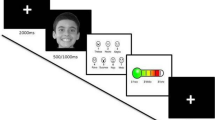Abstract
While numerous studies have investigated children’s recognition of facial emotional expressions, little evidence has been gathered concerning their explicit knowledge of the components included in such expressions. Thus, we investigated children’s knowledge of the facial components involved in the expressions of happiness, sadness, anger, and surprise. Four- and 5-year-old Japanese children were presented with the blank face of a young character, and asked to select facial components in order to depict the emotions he felt. Children’s overall performance in the task increased as a function of age, and was above chance level for each emotion in both age groups. Children were likely to select the Cheek raiser and Lip corner puller to depict happiness, the Inner brow raiser, Brow lowerer, and Lid droop to depict sadness, the Brow lowerer and Upper lid raiser to depict anger, and the Upper lid raiser and Jaw drop to depict surprise. Furthermore, older children demonstrated a better knowledge of the involvement of the Upper lid raiser in surprise expressions.
Similar content being viewed by others
Notes
A pilot study indicated that, because of anime (a style of very popular Japanese animation), most Japanese children expect drawings of Japanese girls to have stylized eyes and false eyelashes. Given that these features would have affected the saliency of the facial components, the material only included a boy’s face and stories involving a boy.
References
Brechet, C., Picard, D., & Baldy, R. (2007). Expression des émotions dans le dessin d’un homme chez l’enfant de 5 à 11 ans. Canadian Journal of Experimental Psychology, 61, 142–153.
Brechet, C., Picard, D., & Baldy, R. (2009). How does Sam feel? Children’s labelling and drawing of basic emotions. British Journal of Developmental Psychology, 27, 587–606.
Bullock, M., & Russell, J. A. (1985). Further evidence on preschoolers’ interpretation of facial expressions. International Journal of Behavioral Development, 8, 15–38.
Cox, M. V. (2005). The pictorial world of the child. Cambridge: Cambridge University Press.
Egami, S. (2010). Preschool children’s understanding of others’ emotions: focusing on differences between emotions. Ehime University Faculty of Education Bulletin, 57, 27–32.
Ekman, P. (1993). Facial expression and emotion. American Psychologist, 48, 384–392.
Ekman, P. (2003). Emotions revealed: Recognizing faces and feelings to improve communication and emotional life. New York, NY: Howl Books.
Ekman, P., Friesen, W. V., & Hager, J. C. (2002). The facial action coding system CD-ROM. Salt Lake City, UT: Research Nexus.
Frijda, N. H. (1986). The emotions. New York, NY: Cambridge University Press.
Gao, X., & Maurer, D. (2009). Influence of intensity on children’s sensitivity to happy, sad, and fearful facial expressions. Journal of Experimental Child Psychology, 102, 503–521.
Golomb, C. (1992). The child’s creation of a pictorial world. Los Angeles, CA: University of California Press.
Gosselin, P., & Larocque, C. (2000). Facial morphology and children’s categorization of facial expressions of emotions: A comparison between Asian and Caucasian Faces. The Journal of Genetic Psychology, 16, 346–358.
Gosselin, P., & Simard, J. (1999). Children’s knowledge of facial expressions of emotions: Distinguishing fear and surprise. Journal of Genetic Psychology, 160, 181–193.
Izard, C. E. (1971). The face of emotion. New York, NY: Appleton-Century-Crofts.
Izard, C. E. (1977). Human emotions. New York, NY: Plenum Press.
Jolley, R. P., Fenn, K., & Jones, L. (2004). The development of children’s expressive drawings. British Journal of Developmental Psychology, 22, 545–567.
Kikuchi, T. (2004). Development of young children’s understanding of their own facial expressions. Japanese Journal of Developmental Psychology, 15, 207–216.
Kliemann, D., Rosenblau, G., Bölte, S., Heekeren, H., & Dziobek, I. (2013). Face puzzle—two new video-based tasks for measuring explicit and implicit aspects of facial emotion recognition. Frontiers in Psychology, 4, 1–13.
Leung, J. P., & Singh, N. N. (1998). Recognition of facial expressions of emotion by Chinese adults with mental retardation. Behavior Modification, 22, 205–216.
Maassarani, R., Gosselin, P., Montembeault, P., & Gagnon, M. (2014). French-speaking children’s freely produced labels for facial expressions. Frontiers in Developmental Psychology, 5, 1–10.
Markham, R., & Wang, L. (1996). Recognition of emotion by Chinese and Australian children. Journal of Cross-Cultural Psychology, 27, 616–643.
Masuda, M. (2014). The development of emotional expression and understanding in young children. Japanese Journal of Developmental Psychology, 25, 151–161.
Picard, D., & Boulhais, M. (2011). Sex differences in expressive drawing. Personality and Individual Differences, 51, 850–855.
Sakuraba, K., & Imaizumi, S. (2001). Affect label comprehension and facial expression interpretation in 2- to 4- year olds: A developmental study. Japanese journal of Developmental Psychology, 12, 36–45.
Sayõl, M. (2001). Children’s drawings of emotional faces. British Journal of Developmental Psychology, 19, 493–505.
Scherer, K. R., & Ellgring, H. (2007). Are facial expressions of emotion produced by categorical affect programs or dynamically driven by appraisal. Emotion, 7, 113–130.
Toda, S. (2003). The relation between understanding of other people’s emotion and prosocial behavior in preschoolers. Journal of Hokkaido University of Education at Kushiro, 35, 95–105.
Vendeville, N., Brechet, C., & Blanc, N. (2015). Savoir identifier et marquer les émotions du personnage d’un récit: Rôle de l’événement déclencheur de l’émotion. Canadian Journal of Behavioural Science, 47, 163–174.
Vicari, S., Snitzer Reilly, J., Pasqualetti, P., Vizzotto, A., & Caltagirone, C. (2000). Recognition of facial expressions of emotions in school-age children: The intersection between perceptual and semantic categories. Acta Paediatrica, 89, 836–845.
Watanabe, Y., & Takiguchi, C. (1986). Relation between empathy of children and that of mothers. Japanese Journal of Educational Psychology, 34, 324–331.
Widen, S. C., & Russell, J. A. (2003). A closer look at preschooler’s freely produced labels for facial expressions. Developmental Psychology, 39, 11–128.
Widen, S. C., & Russell, J. A. (2008). Children acquire emotion categories gradually. Cognitive Development, 23, 291–312.
Widen, S. C., & Russell, J. A. (2010). Differentiation in preschooler’s categories of emotion. Emotion, 10, 651–661.
Yamaguchi, T., Maki, Y., & Yamaguchi, H. (2012). Yamaguchi facial expression-making task in Alzheimer’s disease: A novel and enjoyable make-a-face game. Demantia and Geriatric Cognitive Disorders Extra, 2, 248–257.
Acknowledgements
This research was supported by a Grant-in-Aid for Japan Society for the Promotion of Science (JSPS) fellows Grant Number 16J03042, and the Leading Graduates Schools Program, “Collaborative Graduate Program in Design” by the Ministry of Education, Culture, Sports, Science and Technology, Japan, allocated to Megumi Masuda.
Author information
Authors and Affiliations
Corresponding author
Rights and permissions
About this article
Cite this article
Masuda, M., Gosselin, P. & Nomura, M. Japanese Children’s Knowledge of the Facial Components of Basic Emotions. J Nonverbal Behav 42, 253–266 (2018). https://doi.org/10.1007/s10919-017-0272-1
Published:
Issue Date:
DOI: https://doi.org/10.1007/s10919-017-0272-1




